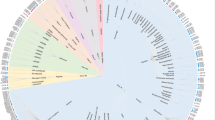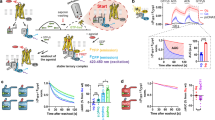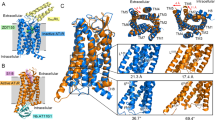Abstract
Here we present a new method that combines protein complementation with resonance energy transfer to study conformational changes in response to activation of a defined G protein–coupled receptor heteromer, and we apply the approach to the putative dopamine D1-D2 receptor heteromer. Remarkably, the potency of the D2 dopamine receptor (D2R) agonist R-(−)-10,11-dihydroxy-N-n-propylnoraporphine (NPA) to change the Gαi conformation via the D2R protomer in the D1-D2 heteromer was enhanced ten-fold relative to its potency in the D2R homomer. In contrast, the potencies of the D2R agonists dopamine and quinpirole were the same in the homomer and heteromer. Thus, we have uncovered a molecular mechanism for functional selectivity in which a drug acts differently at a G protein–coupled receptor (GPCR) protomer depending on the identity of the second protomer participating in the formation of the signaling unit—opening the door to enhancing pharmacological specificity by targeting differences between homomeric and heteromeric signaling.
This is a preview of subscription content, access via your institution
Access options
Subscribe to this journal
Receive 12 print issues and online access
$259.00 per year
only $21.58 per issue
Buy this article
- Purchase on Springer Link
- Instant access to full article PDF
Prices may be subject to local taxes which are calculated during checkout




Similar content being viewed by others
References
Springael, J.Y., Urizar, E., Costagliola, S., Vassart, G. & Parmentier, M. Allosteric properties of G protein-coupled receptor oligomers. Pharmacol. Ther. 115, 410–418 (2007).
Han, Y., Moreira, I.S., Urizar, E., Weinstein, H. & Javitch, J.A. Allosteric communication between protomers of dopamine class A GPCR dimers modulates activation. Nat. Chem. Biol. 5, 688–695 (2009).
Ferré, S. et al. Building a new conceptual framework for receptor heteromers. Nat. Chem. Biol. 5, 131–134 (2009).
Albizu, L. et al. Time-resolved FRET between GPCR ligands reveals oligomers in native tissues. Nat. Chem. Biol. 6, 587–594 (2010).
Rivero-Müller, A. et al. Rescue of defective G protein-coupled receptor function in vivo by intermolecular cooperation. Proc. Natl. Acad. Sci. USA 107, 2319–2324 (2010).
Milligan, G. G protein-coupled receptor hetero-dimerization: contribution to pharmacology and function. Br. J. Pharmacol. 158, 5–14 (2009).
Smith, N.J. & Milligan, G. Allostery at G protein-coupled receptor homo- and heteromers: uncharted pharmacological landscapes. Pharmacol. Rev. 62, 701–725 (2010).
Urban, J.D. et al. Functional selectivity and classical concepts of quantitative pharmacology. J. Pharmacol. Exp. Ther. 320, 1–13 (2007).
Kilts, J.D. et al. Functional selectivity of dopamine receptor agonists. II. Actions of dihydrexidine in D2L receptor-transfected MN9D cells and pituitary lactotrophs. J. Pharmacol. Exp. Ther. 301, 1179–1189 (2002).
Masri, B. et al. Antagonism of dopamine D2 receptor/beta-arrestin 2 interaction is a common property of clinically effective antipsychotics. Proc. Natl. Acad. Sci. USA 105, 13656–13661 (2008).
Mottola, D.M. et al. Functional selectivity of dopamine receptor agonists. I. Selective activation of postsynaptic dopamine D2 receptors linked to adenylate cyclase. J. Pharmacol. Exp. Ther. 301, 1166–1178 (2002).
Mailman, R.B. GPCR functional selectivity has therapeutic impact. Trends Pharmacol. Sci. 28, 390–396 (2007).
Urban, J.D., Vargas, G.A., von Zastrow, M. & Mailman, R.B. Aripiprazole has functionally selective actions at dopamine D2 receptor-mediated signaling pathways. Neuropsychopharmacology 32, 67–77 (2007).
Bosier, B. & Hermans, E. Versatility of GPCR recognition by drugs: from biological implications to therapeutic relevance. Trends Pharmacol. Sci. 28, 438–446 (2007).
Kenakin, T. Collateral efficacy in drug discovery: taking advantage of the good (allosteric) nature of 7TM receptors. Trends Pharmacol. Sci. 28, 407–415 (2007).
George, S.R. et al. Oligomerization of mu- and delta-opioid receptors - Generation of novel functional properties. J. Biol. Chem. 275, 26128–26135 (2000).
Lee, S.P. et al. Dopamine D1 and D2 receptor co-activation generates a novel phospholipase C-mediated calcium signal. J. Biol. Chem. 279, 35671–35678 (2004).
Rives, M.L. et al. Crosstalk between GABA(B) and mGlu1a receptors reveals new insight into GPCR signal integration. EMBO J. 28, 2195–2208 (2009).
Guo, W. et al. Dopamine D2 receptors form higher order oligomers at physiological expression levels. EMBO J. 27, 2293–2304 (2008).
Galés, C. et al. Real time monitoring of receptor and G-protein interactions in living cells. Nat. Methods 2, 177–184 (2005).
Galés, C. et al. Probing the activation-promoted structural rearrangements in preassembled receptor-G protein complexes. Nat. Struct. Mol. Biol. 13, 778–786 (2006).
O'Dowd, B.F. et al. Dopamine receptor oligomerization visualized in living cells. J. Biol. Chem. 280, 37225–37235 (2005).
Rashid, A.J. et al. D1–D2 dopamine receptor heterooligomers with unique pharmacology are coupled to rapid activation of Gq/11 in the striatum. Proc. Natl. Acad. Sci. USA 104, 654–659 (2007).
So, C.H. et al. D1 and D2 dopamine receptors form heterooligomers and cointernalize after selective activation of either receptor. Mol. Pharmacol. 68, 568–578 (2005).
So, C.H., Verma, V., O'Dowd, B.F. & George, S.R. Desensitization of the dopamine D1 and D2 receptor hetero-oligomer mediated calcium signal by agonist occupancy of either receptor. Mol. Pharmacol. 72, 450–462 (2007).
Loening, A.M., Fenn, T.D., Wu, A.M. & Gambhir, S.S. Consensus guided mutagenesis of Renilla luciferase yields enhanced stability and light output. Protein Eng. Des. Sel. 19, 391–400 (2006).
Nagai, T. et al. A variant of yellow fluorescent protein with fast and efficient maturation for cell-biological applications. Nat. Biotechnol. 20, 87–90 (2002).
Hynes, T.R. et al. Visualization of G protein betagamma dimers using bimolecular fluorescence complementation demonstrates roles for both beta and gamma in subcellular targeting. J. Biol. Chem. 279, 30279–30286 (2004).
Mervine, S.M., Yost, E.A., Sabo, J.L., Hynes, T.R. & Berlot, C.H. Analysis of G protein betagamma dimer formation in live cells using multicolor bimolecular fluorescence complementation demonstrates preferences of beta1 for particular gamma subunits. Mol. Pharmacol. 70, 194–205 (2006).
Paulmurugan, R., Umezawa, Y. & Gambhir, S.S. Noninvasive imaging of protein-protein interactions in living subjects by using reporter protein complementation and reconstitution strategies. Proc. Natl. Acad. Sci. USA 99, 15608–15613 (2002).
Zhang, J., Xiong, B., Zhen, X. & Zhang, A. Dopamine D1 receptor ligands: where are we now and where are we going. Med. Res. Rev. 29, 272–294 (2009).
Guo, N. et al. Impact of D2 Receptor internalization on binding affinity of neuroimaging radiotracers. Neuropsychopharmacology 35, 806–817 (2010).
Mansour, A. et al. Site-directed mutagenesis of the human dopamine D2 receptor. Eur. J. Pharmacol. 227, 205–214 (1992).
Paulmurugan, R. & Gambhir, S.S. Monitoring protein-protein interactions using split synthetic renilla luciferase protein-fragment-assisted complementation. Anal. Chem. 75, 1584–1589 (2003).
Terrillon, S. & Bouvier, M. Roles of G-protein-coupled receptor dimerization—From ontogeny to signalling regulation. EMBO Rep. 5, 30–34 (2004).
Dalrymple, M.B., Pfleger, K.D.G. & Eidne, K.A. G protein-coupled receptor dimers: functional consequences, disease states and drug targets. Pharmacol. Ther. 118, 359–371 (2008).
Selbie, L.A. & Hill, S.J. G protein-coupled-receptor cross-talk: the fine-tuning of multiple receptor-signalling pathways. Trends Pharmacol. Sci. 19, 87–93 (1998).
Bygrave, F.L. & Roberts, H.R. Regulation of cellular calcium through signaling cross-talk involves an intricate interplay between the actions of receptors, G-proteins, and second messengers. FASEB J. 9, 1297–1303 (1995).
Kenakin, T. Agonist-receptor efficacy. 2. Agonist trafficking of receptor signals. Trends Pharmacol. Sci. 16, 232–238 (1995).
Meller, E., Puza, T., Diamond, J., Lieu, H.D. & Bohmaker, K. Comparative effects of receptor inactivation, 17 beta-estradiol and pertussis toxin on dopaminergic inhibition of prolactin secretion in vitro. J. Pharmacol. Exp. Ther. 263, 462–469 (1992).
Spongier, D. et al. Differential signal transduction by five splice variants of the PACAP receptor. Nature 365, 170–175 (1993).
Wisler, J.W. et al. A unique mechanism of beta-blocker action: Carvedilol stimulates beta-arrestin signaling. Proc. Natl. Acad. Sci. USA 104, 16657–16662 (2007).
Hern, J.A. et al. Formation and dissociation of M1 muscarinic receptor dimers seen by total internal reflection fluorescence imaging of single molecules. Proc. Natl. Acad. Sci. USA 107, 2693–2698 (2010).
Fonseca, J.M. & Lambert, N.A. Instability of a class A G protein-coupled receptor oligomer interface. Mol. Pharmacol. 75, 1296–1299 (2009).
Dorsch, S., Klotz, K.N., Engelhardt, S., Lohse, M.J. & Bunemann, M. Analysis of receptor oligomerization by FRAP microscopy. Nat. Methods 6, 225–230 (2009).
Guo, W., Shi, L. & Javitch, J.A. The fourth transmembrane segment forms the interface of the dopamine D2 receptor homodimer. J. Biol. Chem. 278, 4385–4388 (2003).
Urizar, E. et al. Glycoprotein hormone receptors: link between receptor homodimerization and negative cooperativity. EMBO J. 24, 1954–1964 (2005).
Costagliola, S., Khoo, D. & Vassart, G. Production of bioactive amino-terminal domain of the thyrotropin receptor via insertion in the plasma membrane by a glycosylphosphatidylinositol anchor. FEBS Lett. 436, 427–433 (1998).
Acknowledgements
This work was supported in part by US National Institutes of Health (NIH) grants DA022413 and MH054137 (J.A.J.), GM078319 (N.L.) and NIH TL1 RR024158-04 (H.Y.) as well as by the Lieber Center for Schizophrenia Research and Treatment and EMBO Long-Term and Basque Country fellowships (E.U.).
Author information
Authors and Affiliations
Contributions
E.U., H.Y. and R.K. performed experiments; E.U., H.Y. and J.A.J. planned experiments; J.A.J. supervised the project; C.G. and N.L. provided reagents and discussed the experimental findings and interpretation of results; E.U. and J.A.J. wrote the manuscript.
Corresponding author
Ethics declarations
Competing interests
The authors declare no competing financial interests.
Supplementary information
Supplementary Text and Figures
Supplementary Figures 1–11 and Supplementary Tables 1–3 (PDF 3697 kb)
Rights and permissions
About this article
Cite this article
Urizar, E., Yano, H., Kolster, R. et al. CODA-RET reveals functional selectivity as a result of GPCR heteromerization. Nat Chem Biol 7, 624–630 (2011). https://doi.org/10.1038/nchembio.623
Received:
Accepted:
Published:
Issue Date:
DOI: https://doi.org/10.1038/nchembio.623
This article is cited by
-
Heterotrimeric Gq proteins act as a switch for GRK5/6 selectivity underlying β-arrestin transducer bias
Nature Communications (2022)
-
Control of glutamate release by complexes of adenosine and cannabinoid receptors
BMC Biology (2020)
-
Revisiting the Functional Role of Dopamine D4 Receptor Gene Polymorphisms: Heteromerization-Dependent Gain of Function of the D4.7 Receptor Variant
Molecular Neurobiology (2019)
-
Temporal reprogramming of calcium signalling via crosstalk of gonadotrophin receptors that associate as functionally asymmetric heteromers
Scientific Reports (2018)
-
Gs- versus Golf-dependent functional selectivity mediated by the dopamine D1 receptor
Nature Communications (2018)



